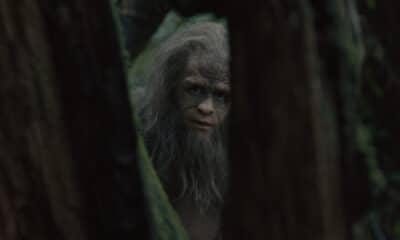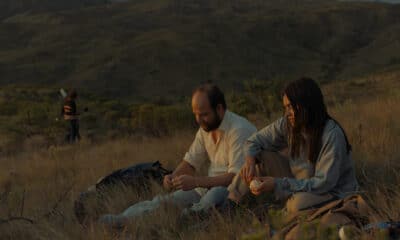RISE OF THE PLANET OF THE APES was a surprise success. After Tim Burton’s failed attempt to reignite audience interest in PLANET OF THE APES we all wondered why Fox were bothering with another venture into the world. We were all foolish though as Rupert Wyatt managed to give the old story a modern and relevant twist, with RISE tackling controversial topics such as animal testing and cruelty.
At the heart of the film was a genetically-altered ape, Caesar, a super-intelligent being who grew-up with humans and believed himself to be human. The moment when he realises that he has been misled and discovers his actual place in society was gut-wrenchingly sad. So immersive is the character that it’s easy to forget that his on-screen visage is just computer-generated pixels. The real reason we love Caesar so much is because of the man responsible for capturing the performance: Andy Serkis.
Ahead of the sequel’s release we at THN were lucky enough to attend an advance footage screening (what we saw took our breath away), but after the screening we were also granted access to Serkis. So we bundled into a small room and jostled with other journalists for a good spot on the round table (we sat directly to Serkis’ left) and took it in turns to fire questions at him. We found him to be a thoroughly lovely and articulate fellow, so chatty in fact that we’ve had to split the interview into two parts for fear of overloading everybody’s heads with his vast vocabulary. In today’s first part, Serkis tells all about his love of performance capture and the work his studio, The Imaginarium, is currently involved in.
Could you tell us about how the storyline evolved? Rupert was developing it early on and when he left what did Matt inherit?
So as you obviously know Rupert Wyatt who directed, brilliantly directed, RISE OF THE PLANET OF THE APES was going to helm this [DAWN OF THE PLANET OF THE APES] and then I think because of scheduling – and he had other projects – he had to leave. Before he left he had started to work on a script with Rick [Jaffa] and Amanda [Silver]. Basically their story was landing a lot later on, so the apes were further evolved and had moved into the world of man a little more I think would be fair to say. When Matt took it over, one of the things that he absolutely adored about RISE was this kind of delicious period of seeing, of not moving too far in advance, so that you’re missing the evolution really. So that’s what he wanted to focus on, so it was re-routed and, as I say, he decided to drop anchor ten years after the event rather than thirty or forty.
So what bits are Rupert, what bits are Matt?
It’s hard to say now to be honest. I know the emotional backbone of the story; Rupert loved the Caesar journey and the growth of Caesar as a character, but he really wanted to make this film which was, again, not a post-apocalyptic apes war movie. Matt was the same; he didn’t want it to, it wasn’t going to be about, in a sense, the ape/human conflict. It was just prior to that, allowing the apes to breathe and to allow them as a community to evolve. But I can’t actually remember to be honest, really really can’t genuinely remember the nitty-gritty of what was going on [during the writing].
This film is filmed in 3D, the first wasn’t. If you could see a scene from RISE in 3D which would it be?
It would probably be… it’s a good point; it would probably be some of the scenes with the apes once they’ve broken out actually. Because 3D is fantastic for action and for lots of depth and layering and so on. Obviously things really pop out, so when the apes took over San Francisco Bridge and so on, that would be a cool one I think.
You’ve said motion capture is just another tool to manifest that final on-screen performance. How have you been able to take part in the evolution of it as an incredible tool? Have you been their guinea pig over the years?
Well, not so much their guinea pig, but I suppose I’ve embraced it as a technology because it’s actually such a liberating tool. I think I’ve been lucky enough to have had the roles to do it with it and embrace the roles to do it with. But also in recent times, in the formation of the Imaginarium, actually working with it very closely on a daily basis because we have this studio at Ealing Studios. At the Imaginarium we’re furthering the arts and crafts of performance capture in film, video game, television, but also in the live theatrical arena and building tools and software to support. We’re sort of like a digital creature workshop in a sense that we work with other people on their film projects as well as evolving our own. We bring together directors and writers, we put them in our performance capture space and help them evolve their digital characters using all of our techniques. We consult, and we have an academy for teaching other actors – and also people behind the computers – to evolve and build bridges to industry from colleges and so forth. So we are building our own specific set of tools to help to have this creature development workshop.
So is that some way going towards an industry standard for this? Or do you think that different people will do things in different ways?
There are different approaches, and there are different systems, and there are different proprietors of software and technology of course. But we, the UK, has I think really needed a creatively led solution to all of these, particularly with the greater influx of movies which are using this technology. As you well know the British film industry is actually in a pretty healthy state at the moment with the amount of films, so that there’s no studio space left anywhere to be found, incredibly. It’s on a roll at the moment so we’re very lucky to take advantage of that.
You mentioned the Imaginarium is helping to train other actors in motion capture and stuff. Did you yourself help out people like Toby [Kebbell] and Judy [Greer] in this film?
Yeah, I mean both, as a consultant with Matt Reeves the director and in fact Imaginarium was credited on this movie as performance capture consultants because that’s the expertise that we bring to it. Also in terms of performance too, it has to be said, though that the performance coach on this was Terry Notary who has worked on many movies, including THE HOBBIT as a physical coach. I mean I worked with Judy, I coached her a little as an actor, and Toby, in fact Toby came in and met us at the Imaginarium very early on. In fact he did his first audition with us so it was great to see him get the part of the role, and he’s turned it into an amazing performance. So we sort of work, we have a presence in the movie other than my role of Caesar.
With motion capture is there something that you can experience that you’ve never experienced before previously? I heard that six actors can be on location and just motion captured at the same time.
Well more than that actually. I mean it’s reached the point that it’s really very handy. It’s moved on incredibly in the last, well…ever since I started it, which is fourteen years ago. It’s taken the visual effects and it’s given true performances to visual effects. It’s moved from being an on stage reference to actually authoring the performance. That’s what I was saying earlier; the technology has got to the point where the fidelity is so strong to the onset performance (and that’s the data), it can be used in this particular instance with a director like Matt Reeves. He won’t move on from filming a scene until he’s got what he wants from the actors, and then the animators and the visual effects artists have to adhere to that exactly. The technology has evolved to enable that to happen and also the pipeline of artists who understand that to be able to take those performances and recreate them faithfully.
And it was all shot on location?
Yes. On location and it was a huge task. It’s not to be underestimated and yet Matt was able to, you know. It still felt very character based and intimate and all about the acting without worrying too much about the technology.
With regard to shooting on location you were in these suits on location, outside, where it was raining. These aren’t ideal conditions for an actor, especially when you’re concentrating on how you’re moving as an ape whilst watching your own footing as you’re climbing over rocks. How did you cope with this?
All of that’s absolutely true, but there were several particularly early-on in the shoot, it was towards the end. Winter in Vancouver was very,very wet. We were standing on top of some trees and logs and all sorts of things, and it was quite precarious a few jumps and quite big leaps which you could really easily roll an ankle or twist or break something. You have to train to do these things. We were an amazingly well prepared team of performers who were also skilled in gymnastics, and stunts and parkour, and were brilliant at all of that.
You spent a bit more time in Lycra probably than Andrew Garfield does as SPIDERMAN. You mentioned training; what do you do to keep in shape for these kinds of roles?
What do I do? Well obviously the build-up to the shoot you’re running, and I cycle quite a bit, but mainly it’s having children, they keep me very fit.
Imaginarium Studios are working on ANIMAL FARM; how does Caesar and his tribe of primates compare to the animals in ANIMAL FARM?
That’s a very good question. It’s so much easier working on primates because they’re humanoid characters, they’re one to one, the correlation is one to one. We’ve been evolving the methodology for how to create the characters for ANIMAL FARM. Which has actually taken a year or so working with very very talented actors and performances to make quadrupeds, to make four-legged animals, to make chicken and geese and pigs and cows, but yet still derived from the actor’s performance. So it’s been really exciting , we work in real time, we have digital avatar puppets on-screen that you can see. The actors are sometimes bonded together with various different pieces of equipment to make spines etc. so you can have two people playing one part and so on. Its a very involved and exciting digital character creation, sort of set-up, for ANIMAL FARM. Then halfway through we were evolving the script at the same time JUNGLE BOOK’s come along, the project that we’re now sort of fully involved in at the moment.
We’ve seen THE RISE OF THE PLANET OF THE APES, and we’ve got DAWN coming, is there an intention to go to THE PLANET OF THE APES or is that ‘been there, done that’?
Oh no, it’s very much the intention I think, there’s already a third film announced. We know what the end result is, we know at some point we’re going to arrive at the 1968 movie.
Not the Tim Burton one?
Well no, not the Tim Burton one particularly, but the original one, the 1968 one. It’s like we could land there or we could get halfway there in the next movie, or we could move on maybe two years. Because its not really about the what happens, it’s about character. It’s about how you get there. If the appetite is there and people want to see the story of how that happens over the course of more than one film I expect it’ll become more apparent.
The performance technology speaks for itself. Is there any film that you’ve watched recently that you thought performance capture would have made a difference?
Let me think. I mean it is used so much now in movies, and that’s not just it, it has to be said, what (and this is slightly off topic), but you do appreciate that when films like this are made, when big budget films are made, there’s a period of shooting that is called pre-vis or pre-visualisation. Performance capture is used a lot in the actual and that’s like a visual storyboard of the entire movie. It’s a very good way of blocking out character and blocking out story. The great thing about performance capture is you can play scenes out in their entirety without, in a motion capture volume, and not have to move cameras about; then when the actors have played out the scene they can go and sit down and you can literally go to the virtual camera and cut together a scene using camera lenses and placing camera lenses wherever you like. So it’s become part of the industry regardless of what it finally is, what characters are manifested on screen, but it is used more and more in all of the big blockbuster comic type pictures. It’s used all the time.
You did some stuff for THE AVENGERS too; what can you tell us about that?
Yeah, the Imaginarium is involved, we’re performance capture consultants for that. We are, we’ve been working with Mark Ruffalo playing the Hulk, with James Spader playing his character, so its really a great way. I mean Mark Ruffalo’s really enjoying it, he’s enjoying the freedom of finally being able to play the Hulk and be on set, and we create an atmosphere for him that allows him to do that fully.
Come back tomorrow for part two which sees Serkis give his views on authorship, his desire to be smothered in talcum powder, and just who would win in a fight between Godzilla and Kong. DAWN OF THE PLANET OF THE APES is released in cinemas today. Read our review here.
Kat Hughes is a UK born film critic and interviewer who has a passion for horror films. An editor for THN, Kat is also a Rotten Tomatoes Approved Critic. She has bylines with Ghouls Magazine, Arrow Video, Film Stories, Certified Forgotten and FILMHOUNDS and has had essays published in home entertainment releases by Vinegar Syndrome and Second Sight. When not writing about horror, Kat hosts micro podcast Movies with Mummy along with her five-year-old daughter.

Latest Posts
-


Apple TV
/ 19 hours agoTrailer: André Holland leads Apple’s new limited series, ‘The Big Cigar’
Apple TV+ has released the full trailer for The Big Cigar, a new, six-episode...
By Paul Heath -


Film News
/ 20 hours agoUK trailer, poster and release date for Sundance smash ‘Sasquatch Sunset’
Premiering in the UK at the Sundance London event in June is the brilliant...
By Paul Heath -


Disney+
/ 22 hours agoNew trailer for ‘Becoming Karl Lagerfeld’ with Daniel Brühl
A trailer has landed for the June-released Becoming Karl Lagerfeld, the Disney+/ Hulu series...
By Paul Heath -


Film News
/ 22 hours agoUK release date revealed for Cannes film ‘The Delinquents’
MUBI has announced the release date for The Delinquents, the Cannes Un Certain Regard-premiering...
By Paul Heath




















